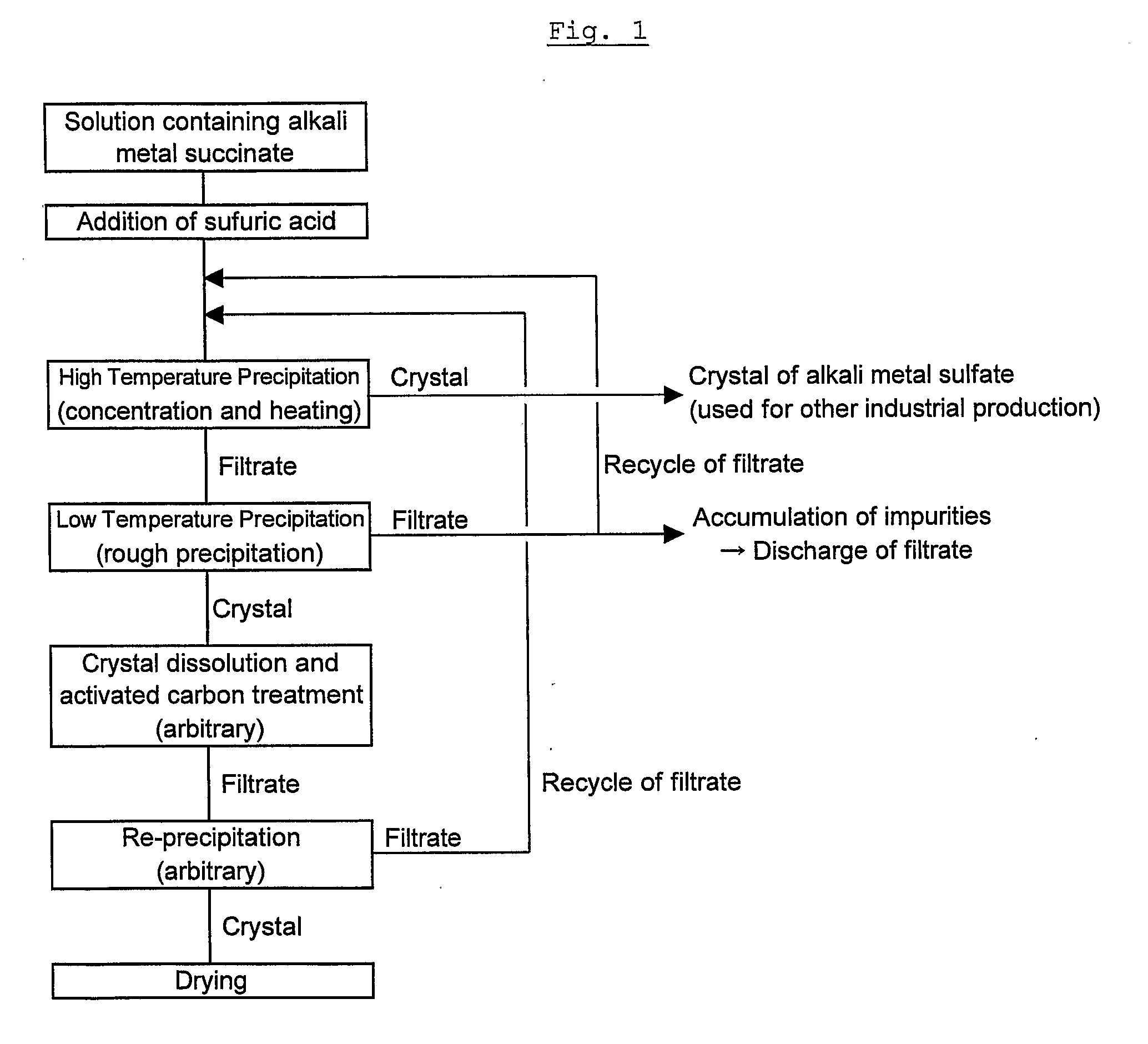Process for producing succinic acid
a succinic acid and process technology, applied in the field of process for producing succinic acid, can solve the problems of high cost of equipment purchase, too many steps, and greatly slowed succinic acid production rate, and achieve the effect of high purity and efficient production
- Summary
- Abstract
- Description
- Claims
- Application Information
AI Technical Summary
Benefits of technology
Problems solved by technology
Method used
Image
Examples
example 1
Separation and Purification of the Reaction Solution (A)
(Addition of Sulfuric Acid)
[0063]To 2080 g (2.0 L) of the reaction solution (A) having the composition as shown in Table 1, 223 g of concentrated sulfuric acid that corresponds to the equivalent amount of the alkali metals contained in the reaction solution (A) was added with stirring to obtain the initial process solution. As shown in Table 2, the initial process solution contained 2303 g (2.2 L) of the reaction solution, containing 231 g (13.7 g / 100 g-water) of succinic acid and 323 g (19.2 g / 100 g-water) of sodium sulfate.
(High Temperature Crystallization)
[0064]Subsequently, the initial process solution was concentrated with a rotary evaporator to be 1082 g to make the concentration of succinic acid 46 g / 100 g-water and sodium sulfate 65 g / 100 g-water, and then all of the solution was transferred into an Erlenmeyer flask with a stopper. The flask was plugged with a stopper and then the solution in the flask was warmed with s...
example 2
Separation and Purification of the Reaction Solution (B)
(Addition of Sulfuric Acid)
[0070]To 2060 g (2.0 L) of the reaction solution (B) having the composition as shown in Table 1, 168 g of concentrated sulfuric acid that corresponds to the equivalent amount of the alkali metals contained in the reaction solution was added with stirring to obtain the initial process solution. As shown in Table 2, the initial process solution contained 2228 g (2.1 L) of the reaction solution, containing 161 g (9.3 g / 100 g-water) of succinic acid and 244 g (14.0 g / 100 g-water) of sodium sulfate.
(High Temperature Crystallization)
[0071]Subsequently, the initial process solution was concentrated with a rotary evaporator to be 795 g to make the concentration of succinic acid 46 g / 100 g-water and sodium sulfate 69 g / 100 g-water, and then all of the solution was transferred into an Erlenmeyer flask with a stopper. The flask was plugged with a stopper and then the solution in the flask was warmed with stirrin...
example 3
Separation and Purification of the Reaction Solution C
(Addition of Sulfuric Acid)
[0079]To 2040 g (2.0 L) of the reaction solution (C) having the composition as shown in Table 1, 100 g of concentrated sulfuric acid was added with stirring to obtain the initial process solution. As shown in Table 2, the initial process solution contained 2140 g (2.1 L) of the reaction solution, containing 72 g (4.0 g / 100 g-water) of succinic acid and 145 g (7.9 g / 100 g-water) of sodium sulfate.
(High Temperature Crystallization)
[0080]Subsequently, the initial process solution was concentrated with a rotary evaporator to be 456 g to make the concentration of succinic acid 36 g / 100 g-water and sodium sulfate 73 g / 100 g-water, and then all of the solution was transferred into an Erlenmeyer flask with a stopper. The flask was plugged with a stopper and then the solution in the flask was warmed with stirring in a water bath at 80° C. in the hermetically closed state. After the concentrated solution was stir...
PUM
| Property | Measurement | Unit |
|---|---|---|
| temperature | aaaaa | aaaaa |
| temperature | aaaaa | aaaaa |
| Temperature | aaaaa | aaaaa |
Abstract
Description
Claims
Application Information
 Login to view more
Login to view more - R&D Engineer
- R&D Manager
- IP Professional
- Industry Leading Data Capabilities
- Powerful AI technology
- Patent DNA Extraction
Browse by: Latest US Patents, China's latest patents, Technical Efficacy Thesaurus, Application Domain, Technology Topic.
© 2024 PatSnap. All rights reserved.Legal|Privacy policy|Modern Slavery Act Transparency Statement|Sitemap



